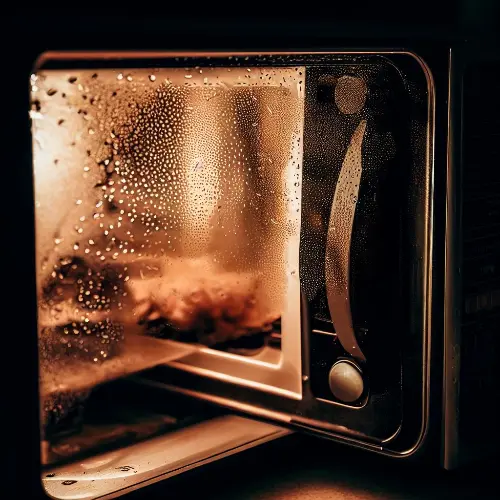Table of Contents
Why Does My Microwave Get So Wet Inside?
Many people have experienced condensation building up inside their microwave oven. Opening the microwave door to find pools of water on the walls, turntable, and roof is a common annoyance. This condensation occurs when water vapor, produced when cooking or reheating food, condenses on the cooler internal surfaces. But what causes this, and how can you prevent excess moisture inside your microwave?
What Causes Condensation in Microwaves?
Condensation forms inside your microwave for a few key reasons:
Foods Release Moisture During Cooking
Foods, especially those with a high moisture content like soups, vegetables, and meat, release significant water vapor when cooked in the microwave. This water evaporates from the food and enters the air inside your microwave. When the water vapor comes into contact with cooler surfaces inside the appliance, it condenses into liquid water droplets.
The Confined Space Traps Steam and Moisture
Being an enclosed and airtight appliance, the microwave traps all the steam and moisture released by food as it cooks. With no way to escape, the water vapor remains inside the microwave, leading to excessive condensation building up.
Microwaves Rapidly Heat Foods
Microwave ovens are designed to very quickly heat food items by exciting water molecules. This rapid heating causes foods to release moisture faster than in other cooking methods. More steam in less time increases the likelihood of condensation.
The Air Inside is Cooler Than the Food
Microwaves work by heating the food itself, not the air inside. So freshly cooked food straight out of the microwave can be hundreds of degrees hotter than the surrounding air. This temperature difference causes water vapor to rapidly condense on any nearby surface cooler than the food.
Common Causes of Excessive Condensation
While some moisture inside is normal, excessive condensation usually indicates an underlying issue. Here are some common causes of heavy condensation buildup:
- Leaving the door open after cooking – This allows steam to escape and cooler air to enter, causing water vapor to rapidly condense.
- Cooking food with a high water content – Foods like frozen meals, soups, and vegetables contain a lot of water that gets released as steam during cooking.
- Reheating leftovers – Reheating already cooked food adds more moisture to the interior.
- Not allowing food to stand – Food retains heat and continues steaming after cooking. Removing food immediately allows this steam to condense.
- Overcooking – Cooking food longer than necessary evaporates more liquid.
- High microwave power settings – Higher power cooks food faster and releases more steam.
- Blocked ventilation – Impaired ventilation prevents steam from escaping.
Where Does the Excess Moisture Appear?
Condensation gathers in certain parts of the microwave:
- Inside walls – Being made of metal, the walls stay relatively cool, causing water vapor to rapidly condense on contact.
- Door and door seal – Much like the walls, the plastic door and rubber seal remain cooler than the interior, promoting condensation.
- Roof and vents – Steam rises and condenses on the ceiling and any overhead vents.
- Turntable – Being made of glass or plastic, the turntable cools quicker than microwaved food and accumulates condensation.
- Microwave floor – Liquid dropping from other surfaces gathers in puddles here.
Preventing Excessive Moisture Buildup
You can take steps to prevent excessive condensation inside your microwave:
- Leave the door open for a few minutes after cooking to vent steam.
- Use lower power levels to heat food more gently and release less moisture.
- Allow food to stand after cooking so the remaining steam dissipates.
- Keep microwave vents clear so ventilation fans work properly.
- Use microwave-safe lids to contain some steam in pots and bowls.
- Clean up spills immediately to limit excess moisture.
- Avoid overcooking food to prevent extra steam production.
- Open a nearby window when cooking longer or reheating lots of food to allow moisture to exit.
Consequences of Excessive Moisture
Too much condensation inside your microwave can cause issues:
- Messes requiring frequent wiping down of surfaces.
- Longer cook times as moisture absorbs microwave energy.
- Damage to interior surfaces from pooling water.
- Potential electrical dangers from water dripping near wiring.
- Mold and mildew growth from persistent dampness.
- Rusting of cavities and ventilation systems.
- Food splatters getting washed onto walls and ceilings.
- An overall unsanitary environment.
When to Worry About Condensation
While some temporary surface wetness is normal, consistent and excessive condensation could indicate problems with your microwave:
- Pools of water left after every use may point to impaired ventilation.
- Constant dampness suggests a possible air leak allowing humid outdoor air inside.
- Water dripping from vents indicates a blocked ventilation pathway that needs cleaning.
- Condensation outside the unit could mean a major leak or issues with an over-the-range vent fan.
In these cases, troubleshoot the appliance and contact a repair technician if needed. Persistent condensation left unchecked can lead to permanent damage.
Tips for Cleaning Up Excess Moisture
To quickly clean up condensation mess inside your microwave:
- Wipe down surfaces with paper towels, a clean cloth, or a sponge.
- Use a mild all-purpose cleaner to sanitize and remove grime. Avoid abrasives.
- For stubborn dried-on spatters, try microwave-safe cooktop cleaning creams.
- Remove the turntable and wash it separately in warm soapy water.
- For heavy buildup, microwave a bowl of water for 2-3 minutes to loosen grime before wiping clean.
- Dry all surfaces thoroughly to discourage mold growth.
- Leave the door open for 15-20 minutes after cleaning to air out any lingering moisture.
Maintaining a Condensation-Free Microwave
With proper use and care, you can minimize annoying condensation in your microwave:
- Ventilate after reheating or cooking longer.
- Avoid overcooking foods to release excess moisture.
- Wipe spills immediately before they contribute to the problem.
- Leave the door ajar after use to allow ventilation.
- Clean ventilation filters regularly to improve airflow.
- Replace old gaskets around the door if they appear cracked or warped.
With a little diligence, you can keep your microwave free of excess annoying moisture. However, some condensation will always be inevitable when cooking in a humid environment.
FAQs
Why does my microwave get so wet inside?
There are a few reasons why your microwave may get wet inside. One of the main reasons is condensation. When you heat food in the microwave, the moisture inside the food turns into steam. If the vent in your microwave is blocked or not working properly, the steam will have nowhere to escape and will condense on the interior walls of the microwave. This is what causes the inside of the microwave to become wet.
How can I avoid condensation inside my microwave?
To avoid condensation inside your microwave, make sure that the vents are not blocked and that they are in good working condition. Additionally, try to use microwave-safe containers with lids when heating food with a high moisture content. The lids will help trap the steam and prevent it from escaping into the microwave. Lastly, avoid opening the microwave door frequently during cooking as this can also contribute to the formation of condensation.
Why is there condensation outside my microwave?
If you notice condensation outside your microwave, it could be because the steam and condensation produced inside the microwave are finding their way out through gaps in the microwave door. This can happen if the door seal is worn out or not properly aligned. When the steam escapes through these gaps, it comes into contact with cooler surfaces and condenses, resulting in moisture on the outside of the microwave.
Can I use my microwave with the door open?
You should never use your microwave with the door open. Microwaves are designed to operate with the door securely closed to contain the heat and radiation generated during the cooking process. Using your microwave with the door open can be extremely dangerous and may result in harm to you or damage to the appliance.
Is it normal for the inside of a microwave oven to get hot?
It is normal for the inside of a microwave oven to become hot during use. Microwaves work by emitting electromagnetic waves that excite the water molecules in food, causing them to heat up. As a result, some of the heat will transfer to the interior walls of the microwave. However, if the interior becomes excessively hot or if you notice any other unusual behavior, it is recommended to have the microwave inspected by a professional.
How do I clean the inside of my microwave?
To clean the inside of your microwave, start by wiping down the interior walls and ceiling with a damp cloth or sponge. For stubborn stains or food residue, you can use a mixture of mild dish soap and water. Avoid using abrasive cleaners or scouring pads as these can damage the microwave’s interior. After cleaning, make sure to thoroughly rinse and dry the inside of the microwave to prevent any moisture or detergent from affecting the performance of the appliance.
Can the use of my microwave create steam?
Yes, when you heat food in the microwave, it can create steam. The microwave heats the water molecules inside the food, causing them to turn into steam. This steam may collect on the door or the interior walls of the microwave, resulting in condensation.
Why do I see moisture forming on the inside of the microwave door?
The moisture forming on the inside of the microwave door is a result of the steam and condensation produced during cooking. As mentioned earlier, when the steam comes into contact with cooler surfaces, such as the door, it condenses and forms moisture. This is a normal occurrence and can be prevented by following the tips mentioned earlier on how to avoid condensation.
Can I put food inside a microwave-safe container to prevent condensation?
Yes, using microwave-safe containers with lids can help prevent condensation. The lids will trap the steam and prevent it from escaping into the microwave, reducing the chances of condensation forming on the interior walls. Just make sure to follow the manufacturer’s instructions for using the container in the microwave and avoid using containers that are not labeled as microwave-safe.
I have an over-the-range microwave, are there any specific steps to avoid condensation?
If you have an over-the-range microwave, make sure that the vent fans are properly functioning. These fans are designed to push moisture outside the microwave, preventing it from accumulating inside. If the vent fans are not working or are blocked, the likelihood of condensation inside the microwave increases. Regularly check and clean the vent fans to ensure their effectiveness in removing moisture.
Conclusion
Condensation inside your microwave is a common annoyance caused by steam from cooking food coming into contact with cooler oven surfaces. While some moisture is unavoidable, excessive condensation can create messes and even damage the appliance over time.
Follow the tips outlined to minimize water vapor buildup by using proper cooking techniques and improving ventilation. With the right strategies, you can keep the inside of your microwave as dry as possible for better performance and easier cleaning.

I’m Ian Welkins, a seasoned professional in the kitchen industry. My passion now drives me to provide invaluable insights into the world of top-notch kitchen products. With years of hands-on experience, I’m your go-to source for culinary excellence.











